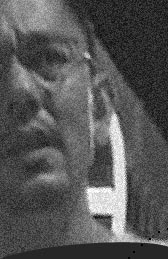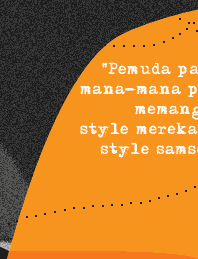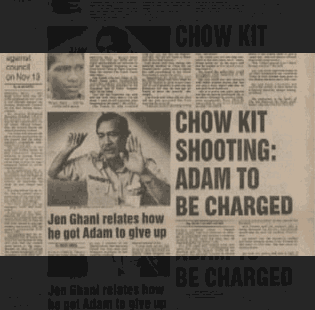The
initial idea for "The Big Durian" came about after its director Amir
Muhammad completed a cycle of six video-essays, "6horts"
in the middle of 2002. Each of those shorts delved into hot-button
aspects of Malaysian life, and had themes including the identity card,
Friday prayers, Singapore-Malaysia ties, political detentions and
race relations. These shorts did not use actors or stories but instead
minimal digital imagery combined with essayistic text.
After
"6horts", Amir conceived of an idea that would incorporate many
of these themes into a single feature-length movie. Amir's thoughts
turned to the amok of Private Adam that had so terrified the Kuala
Lumpur population in October 1987. Amir was 15 at that time and
remembered it as "the first instance in which national poliitcs
impacted on my daily routine. I was told to stay away in school
and from certain areas. This was also the first time I remember
disbelieving the national media. I watched the poiliticians on TV
and got the sense that some of them were 'acting.' I was interested
to delve back into that formative period of recent Malaysian history."
Many
of the "thorny topics" that were paramount in October 1987, such
as party-political intrigue, detentions without trial, press freedom,
and even Chinese education, have continued to surface periodically
in Malaysia. In order to make the issues accessible to a young audience,
an unconventional approach was chosen. Instead of a straight-forward
documentary, "The Big Durian" instead incorporates some fictional
monologues. Documentaries have a very staid image in Malaysia, and
this mix was thought to be more palatable to its target audience.
The truth-fiction mix was also chosen because it helped to define
the mood of the time, when rumours and hearsay were as important
(some would say MORE important) than the national media.
In December
2002, Amir approached fellow independent filmmaker James Lee to
see if he would be interested to produce the movie under his Doghouse
73 Pictures outfit. Lee is an accomplished director in
his own right, whose most recent DV film "Room to Let" (2002) was
just starting its festival run that would eventually take in Rotterdam,
Hong Kong, Montreal and Turin, as well as a rave review from Variety
magazine. He had set up Doghouse 73 Pictures to further the cause
of low-budget, stylistically independent, filmmaking in Malaysia.
Lee
agreed, and production of "The Big Durian" began. The budget was
RM50,000 (USS13,000), including sponsorship in kind from the production
houses Red Communications and Titik Video. Venues were sponsored
by several parties including The Actors Studio, Malaysia's premier
privately-owned theatre company.
Auditions
were held in January 2003. Notices were sent out to the newspapers
and websites, inviting people to come forward to "tell us what you
remember about the amok of Private Adam." Over 100 came forth over
two weekends. Applicants were also invited to talk about issues
that were of relevance during the thorny climate of October 1987,
such as politics, ethnicity, corruption and even the royal family.
Due to restrictive censorship, these issues are not usually discussed
critically in Malaysian cinema.
Amir
compiled all of these interviews. He decided that some of them would
be uttered on camera by the actual protagonists, while others would
be given to actors (with the permission of the interviewees). This
combination of acting, non-acting and rehearsed naturalism gave
"The Big Durian" a texture he was aiming for.
The
movie was shot in a whirlwind 7 days with two DV Cam cameras, a
Sony PD150 and a Sony PD100. The cinematographer Woo Ming Jin (alias
Ming Jin Woo) had just graduated from film school at the San Diego
State University and was looking forward to starting a career in
his native Malaysia. He had made several award-winning shorts, including
"Mina in Perfection" and "The Day After Tomorrow" while he was in
California, and "The Big Durian" was his Malaysian debut. Additional
camera-work was done by Tan Chui Mui, a young tutor at Malaysia's
Multimedia University who is an accomplished director of shorts
herself, whose work has been shown in festivals including Bangkok
and Cork. This project marked her debut involvement in a feature-length
project.
"The
Big Durian" mixes colour DV photography with black-and-white still
images. The stills were taken with a film camera by Azrul Kevin
Abdullah, one of Malaysia's most successful young photographers,
with extensive experience in advertising and arts-related promotional
work. To get an idea about the type of images that would be suitable
for the movie, Azrul sat in during the shoot. He says: "It was an
experience to watch each take. Each short recollection though very
personal, weaves a vivid tale about the fabric that is Malaysian
society."
Many of the actors featured in "The Big Durian" are well-known to
Malaysian audiences and some have been featured in Hollywood movies.
Two of them, Patrick Teoh (playing the part of a gossipy Cantonese-speaking
waiter) and Shantini Venugopal (playing a tour agent whose tour
was cancelled in wake of Private Adam's amok) had supporting roles
in the Jodie Foster/Chow Yun-Fatt vehicle "Anna and the King", which
had been shot in Malaysia. Rashid Salleh (who plays a former jelly
salesman) is one of the hottest starts in the Malaysian entertainment
scene, thanks to his roles in films, TV shows and theatre. Low Ngai
Yuen (playing a CD saleswoman recalling her school days) is also
a popular and articulate TV host who recently branched out into
acting for the stage and TV, and also directing shorts.
In order to confound the truth-fiction mix, some of the people in
"The Big Durian" are actors who are talking about their own experiences!
These include Anne James, a respected veteran of the English-language
theatre scene, and Namron, who had most recently starred in the
big-budget Malaysian epic "Paloh", which had been funded by the
government and won a Special Jury Prize at the Asia-Pacific Film
Festival.
Other colourful personalities in the movie are the controversial
academic Farish A. Noor (giving an overview of local socio-politics),
whose writings calling for a more secular brand of Malaysian politics
frequently anger the religious right; and poet Salleh Ben Joned
(explicating on the unique Malay phenomenon of the amok), known
for his spicy odes to sexuality.
The shoot produced 19 hours of footage and went smoothly thanks
to the efficiency of the production manager Grace Looi. She has
wide experience in theatre, including foreign productions in Kuala
Lumpur, and this was her first time working on a movie.
The task of assembling the footage fell on Terence Raj, an in-house
editor at Red Communications, who is experienced at TV productions
including "3R", a magazine show aimed at young women, which has
won several regional awards. Editing went on for three months and
several different rough-cuts were produced and tested.
A short excerpt was rushed to the office of the Singapore International
Film Festival (SIFF) in late January 2003, with the promise that
the movie will be complete in time to premiere during the festival
in April. The movie was accepted into the Asian Films category based
on this.
An exciting aspect of "The Big Durian" is that the crew consisted
of many voices in the burgeoning Malaysian independent film scene,
aside from Amir, Lee, Woo and Tan. The animation sequences and opening-credit
titles were done by Deepak Kumaran Menon, a tutor at the Multimedia
University, who has made several animated shorts of his own, which
have also been shown in various festivals.
Music was scored by 26-year old Hardesh Singh, who mixed a jazzy
beat to traditional sounds such as the gamelan and gabus. Hardesh
is the co-founder of the eclectic band 50 Cents Jazz Club, which
has played several gigs in Kuala Lumpur. Due to budget constraints,
the task also fell on him to supervise the final sound-mix. This
was Hardesh's first involvment in a movie; he found the experience
"very satisfying" and looks forward to more work in the field.
The first screening of "The Big Durian" was held in Kuala Lumpur
on 23 April. The screening was to raise funds for the award-winning
independent news-site Malaysiakini.com which has frequently been
the target of intimidation by the government. The content of the
movie, which seeks to plainly address many of the colours and contradictions
of Malaysian society, made it a perfect match for the website. The
screening was a sold-out success and within hours, reviews in Malay
appeared on the Internet, hailing the movie as an important development
in local cinema.
The Hong Kong-based Far Eastern Economic Review agreed:
"EARLY
this year, Malaysian independent cinema came of age. Just off Merdeka
Square, where Malaysia was born, an audience packed into the Actors
Studio Theatre for the premiere of The Big Durian. Named after a
tongue-in-cheek term for Kuala Lumpur, this personal essay is the
most mature work so far by journalist-turned- film-director Amir
Muhammad, 30, who has become the informal ringleader of a new generation
of cinematic taboo-busters.
This film focuses on the racial jitters and political machinations
surrounding an incident in 1987, when a Malay army private named
Adam ran amok with a gun, killing one and injuring two. The film
mixes real and re-enacted interviews to offer a straight-on but
witty examination of ultra-sensitive issues -- racial tensions,
a national herd mentality -- that Malaysians avoid discussing."
A week later, "The Big Durian" officially premiered at the Singapore
International Film Festival. It too was a success and a repeat screening
was organised by the Singapore Film Society (SFS) a month later.
It became the most successful event in that calender year for the
SFS.
To date, "The Big Durian" has been invited to about a dozen festivals.
It won a Special Mention for the New Asian Currents Prize at Japan's
prestigious Yamagata International Documenatry Film Festival in
October 2003. The jury citation read:
"While
taking up a historical incident of superficially little relevance,
the film reveals a deep social consciousness through a non-serious
filmic style. The director uses his eccentric imagination and variety;
full means of expression to reach a politically apathetic young
audience."
It also became the first Malaysian work to screen at the International
Documentary Film Festival of Amsterdam (IDFA), where it made its
European premiere. And in 2004 it became the first Malaysian work
to be invited to the famous Sundance Film Festival.
THE END.











